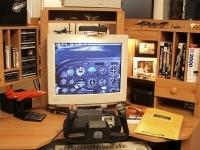
These are actually quite common questions, but before I address them, I should state that I am the author of several books on flight simulations including "Microsoft Flight Simulator 98: Inside Moves," "Instrument Flight Techniques with Flight Simulator 98," Microsoft Combat Flight Simulator: Inside Moves," and "Microsoft Flight Simulator 2000 Official Strategies & Secrets" for Microsoft Press and Sybex Publishing. So one may view me as being either biased towards PC-based flight simulators, or perhaps having a little more insight into the capabilities and limitations of these desktop simulators than most. I'll leave that determination up to you. (Ben is also a CFII, AGI, IGI, and holds all fixed-wing, land ratings. -ed) The first point is there is no such thing as a 100% replacement for actual flight training at this level, and there's unlikely to be a complete replacement for quite a long time--and I seriously have my doubts there ever will be. Second, Flight Simulator 2000, like most desktop flight simulations, is a tool, and needs to be viewed as such. You wouldn't give a welding machine to someone without proper instruction and then expect them to create perfect, safe welds, without developing any bad habits. Simulators work the same way: you simply can't expect someone using Flight Simulator 2000 without proper guidance to do the same in aviation terms. As with my welding example, proper instruction from the start will make all the difference in world. We've had great success using Flight Simulator 2000 for primary flight training in our TEFT (Technology Enhanced Flight Training) program. Although I'm not at liberty to discuss our proprietary processes, techniques, software, or other training materials, please allow me to touch upon a few points that may help everyone understand what's involved with using FS2K for primary flight training. My intent is to help those not really familiar with this technology to avoid failure and reduce the probability of creating more problems than they solve--which, as you'll see, is highly likely if one attempts this route without being familiar with some of the major factors involved. 1. You need the right hardware (I'm referring to the flight controllers as well as the computer itself), configured and calibrated properly. These often looked and/or misunderstood aspects of flight simulations can mean the difference between a useful flight training tool and a totally unrealistic source of frustration. 2. You need accurate virtual aircraft flight models. If your flight models are, to put it mildly, "K-wrap", well, the likelihood of a budding pilot developing bad habits goes up tremendously. 3. You need to develop a flight simulator training regimen that utilizes its strengths and minimizes its weaknesses. (Recall that no flight simulation is 100%.) What I'm getting at here is you need to be very familiar with FS2K's limitations and either avoid them completely, or create ways to eliminate or minimize possible negative transfer (e.g. bad habits inappropriate for the tasks at hand). Does this require a lot of effort? Perhaps. But so far, the benefits have far outweighed the effort expended in getting it right. Would I suggest that a CFI who lacks the ability to address the above points use FS2K with their primary flight training students? I'd say no. You can potentially do more harm than good if you don't know what you're doing--just as one would do with a welding machine. Regarding Stephen's questions:
This is a common negative transfer problem caused by the limitation of flight simulations that use a single monitor (created by the user--not from our program mind you!). One technique that I've used successfully is to cover up the offending instrument(s). Your student may be very uneasy about losing their trusted instrument(s) for a few minutes, but they almost always end up liking the view outside much better in the end. "Is using FS2000 to learn PPL flight maneuvers even a good idea?" I think one can pretty much sum it up by saying it is a good idea, provided you use it as you would any other specialized tool. It can't do everything, but you can certainly use it to your advantage for what it does well (some include use as visual aids and dynamic examples of concepts being covered). "Does FS2000 give the student pilot bad habits?" It can, and it will--if the student is not guided properly with its use. However, given the right guidance, sims like FS2K can be a wonderful training tool because you can introduce or explain topics that can be learned better on the ground, without the added pressure of having to keep the airplane in the air with ATC barking at you (my apologies to ATC, I like them, I really do!). We've found that the student is able to understand what's going on with their airplane much easier and more thoroughly. Finally, the ability to practice at their leisure has its own beneficial attributes (law of exercise). In the end, I adamantly believe that desktop flight simulations will become mainstays of flight training in the 21st century. I'm not saying that traditional flight training will go away. Not at all. What will happen is that as technology advances and software design becomes more sophisticated, programs such as Microsoft Flight Simulator will become accepted and valued tools for flight instructors. Traditional flight training (the old "you watch me, then I'll watch you") will be enhanced by desktop flight simulators, allowing the student to better understand their lessons--before stepping into the cockpit, and far beyond that. -Ben Chiu
|

![[Next]](../buttonNextI.jpg)
